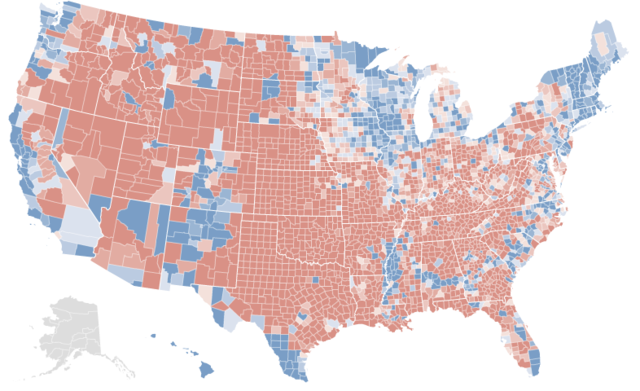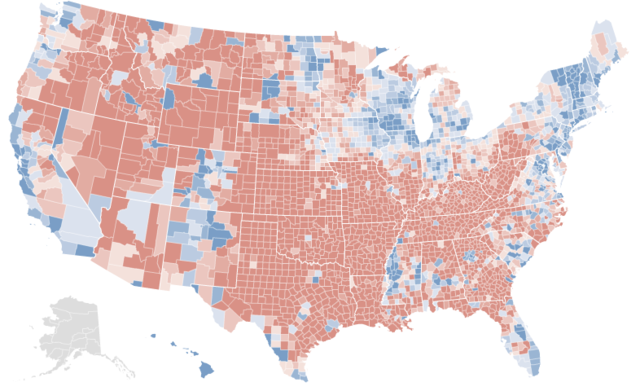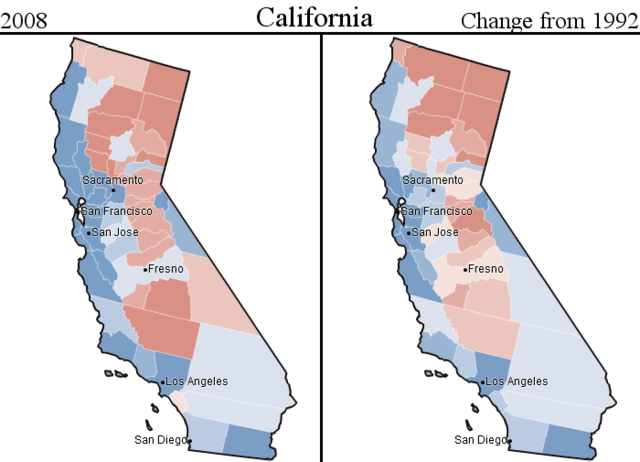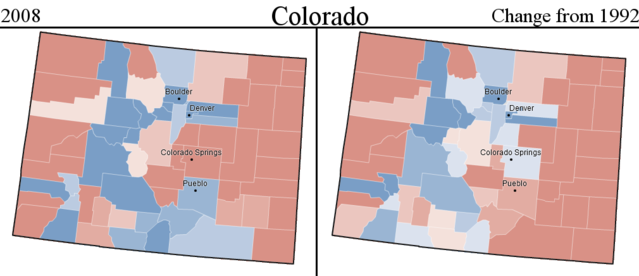By: Inoljt, http://mypolitikal.com/
In my previous post, I noted that almost all the counties President Barack Obama won have become more Democratic since 1992, while almost all the counties Senator John McCain won have become more Republican since 1992.
In fact, comparing maps of the 2008 presidential election and the county changes from 1992 indicates a striking correlation.
Here is the 2008 presidential election:

Here are the changes from the 1992 presidential election:

This hints at a disturbing picture of electoral polarization. More analysis below.
On the one hand, all this is somewhat intuitive. If a Democratic candidate does well in a specific place, he or she probably improved on a previous Democrat’s performance there – and vice versa. Moreover, these maps do not imply that all blue regions became more Democratic (nor the opposite); rural Appalachia, in the most famous instance, has trended sharply Republican, while much of suburban American has gone in the opposite direction.
On the other hand, this phenomenon does not constitute a mathematical rule. If a Democratic candidate wins a county, that doesn’t necessarily imply that he or she improved upon a previous Democrat’s performance. He or she could have done worse but still won; the previous Democrat might have overperformed, or the Republican might have encouraged cross-over voting.
Yet by and large, this has not been the case. Obama practically always outperformed former President Bill Clinton in today’s Democratic counties. Mr. McCain practically always overperformed former President George H. W. Bush in today’s Republican counties.
Taking a look at selected states provides a powerful illustration of this fact.
Here is California:
Here is Colorado:
All this implies something rather disturbing: electoral polarization has been steadily increasing. Obama only improved on Mr. Clinton’s performance in the counties Obama won. McCain only improved on Mr. Bush’s performance in the counties McCain won. The almost total lack of cross-over gain suggests that each party has come to depend on deepening their base, rather than widening the electorate and appealing to moderates.
That America is getting more divided has, of course, been known for a fairly long time. In some ways the maps exaggerate the polarization: 1992 Clinton appealed to many Republicans, while Obama’s strength lay amongst the Democratic base. Then there is the Ross Perot effect, which lowered margins in both party strongholds (e.g. New England, the Plains states).
But perhaps a bit of exaggeration is needed. Polarization has rarely been good for any country, and its increasing prevalence bodes poorly for the future of the United States. A map like this provides a potent illustration of polarization in action; indeed, I have never encountered a more striking image of its increase. Such a picture might do us some good.
(Note: Credit for all maps is given to the NYT; some images have been modified.)


I mean you don’t see this same stuff with 1996, 2000, or 2004 (you just see a democratic trend in 2000 and 2004, obviously).
This, I think, is basically showing a rural-urban realignment. Clinton did relatively well in rural, republican areas, Obama didn’t do as well -> thus you see rural, red areas getting redder from 1992/2008. Urban, blue areas have gotten bluer and more populated. Part of this has to do with a realignment in party voters (see Southern Democrats), some of this has to do with urbanization. Some of this might have to do with increased turnout. Some of this has to do with anti-Bush sentiment in blue areas, and some of this has to do with anti-Obama sentiments in red areas (mainly in the South). Some of this might have to do with 3rd party vote.
Keep in mind that Clinton was a Southerner, Obama is a Northerner/Midewesterner. Northern/Atlantic/Pacific West/Midwestern areas became bluer, Southern and Big Sky Country became redder.
I agree to some extent about the polarization, but I’d say there are some other circumstances to explain why this happened.
Since Harrison (William Henry, Tippacanoe and Tyler too), seems like most Presidents at least present themselves as being from small towns.
To contrast themselves from the big city, W had his ranch, Clinton had Hope, Reagan had his time in Iowa, Carter was the man from Plains, Ford was from Omaha, Nixon from Yorba Linda, LBJ from some small TX town, etc.
There was Perot in 1992 who stole alot of votes mainly from George Bush Sr. in the Big Sky Country and in Maine which shows why some counties in Maine are trending more Republican. I thought the Big Sky country is trending more Democratic with alot of Liberals from California moving in (my neighbor’s Dad has a house in Montana.) Then I noticed tiny rural counties trending towards Obama and Idaho which is getting alot of people from the Orange County area (but they got at least one Liberal because I knew one who moved there.) I realized the big swing to Obama over Kerry was that Obama did not portray himself as a tough on guns candidate and alot of rural people in the rural west do not like the religious right, many are Conservative because they are Libertarian, not because of religion. Yes, there are Utah’s Mormons but there may have been some backlash against Romney’s loss. There is probably a better reason for Obama doing much better in Utah than Kerry.